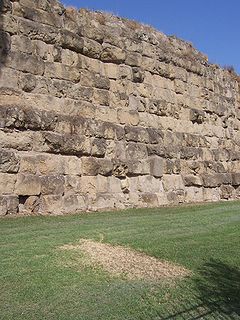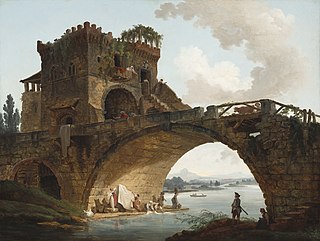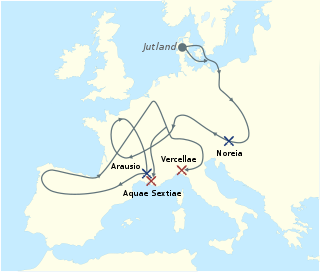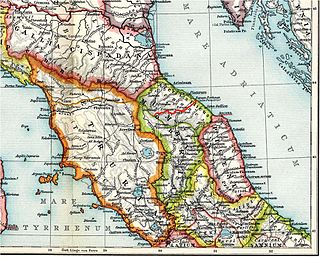 W
WThe Battle of the Allia was a battle fought c. 387 BC between the Senones – a Gallic tribe led by Brennus, who had invaded northern Italy – and the Roman Republic. The battle was fought at the confluence of the Tiber and Allia rivers, 11 Roman miles north of Rome. The Romans were routed and Rome was subsequently sacked by the Senones. According to scholar Piero Treves, "the absence of any archaeological evidence for a destruction-level of this date suggests that [this] sack of Rome was superficial only."
 W
WThe Battle of the Anio River was fought in 361 BC between the Roman Republic, led by the dictator Titus Quinctius Pennus Capitolinus Crispinus, and a group of Gauls who had encamped near the Via Salaria beyond the bridge over the Anio River.
 W
WThe Battle of Burdigala was a battle of the Cimbrian War that occurred in the year 107 BC. The battle was fought between a combined Germanic-Celtic army including the Helvetian Tigurini under the command of Divico, and the forces of the Roman Republic under the command of Lucius Cassius Longinus, Lucius Caesoninus, and Gaius Popillius Laenas. Longinus and Caesoninus were killed in the action and the battle resulted in a victory for the combined tribes.
 W
WThe Battle of the Isère River took place near the modern day French town of Valence at the confluence of the Isère and Rhône rivers. A first confrontation had been won by Gnaeus Domitius Ahenobarbus at the Battle of Vindalium, further south in the Rhône Valley, before Ahenobarbus and Quintus Fabius Maximus Allobrogicus joined their forces, defeating a confederation of Allobroges, Arverni and some Salluvii warriors at the Isère River.
 W
WThe Battle of the Rhône Crossing was fought in autumn of 218 BC during Hannibal's approach to the Italian Alps, when an army of the Gallic Volcae tribe attacked the Carthaginian army on the east bank of the Rhone. Acting on behalf of a Roman army camped near Massalia, the Volcae intended to prevent the Carthaginians from crossing the Alps and invading Italy. Before crossing the river, the Carthaginians sent a detachment upriver under Hanno, son of Bomilcar, to cross at a different point and take position behind the Gauls. Once the detachment was in place, Hannibal began to cross the river with the main contingent of the army. As the Gauls massed to oppose Hannibal's force, Hanno attacked from behind, leading to a route of the Volcae army. This battle was Hannibal's first major battle and victory outside of the Iberian Peninsula and gave him an unopposed path to the Alps and into Italy.
 W
WThe Battle of Silva Litana was an ambush during the Second Punic War that took place in a forest 75 miles northwest of the Roman city of Ariminum in 216 BC. The Gallic Boii surprised and destroyed a Roman army of 25,000 men under the consul-elect Lucius Postumius Albinus. Only ten men escaped the ambush, few prisoners were taken and Postumius was killed, decapitated and his skull covered with gold by the Boii. News of the military disaster, coming either several days or months after the defeat at Cannae, triggered a renewed panic in Rome and the Romans postponed military operations against the Gauls until the conclusion of the Second Punic War.
 W
WThe Battle of Telamon was fought between the Roman Republic and an alliance of Celtic tribes in 225 BC. The Romans, led by the consuls Gaius Atilius Regulus and Lucius Aemilius Papus, defeated the Celts led by the Gaesatae kings Concolitanus and Aneroëstes. This removed the Celtic threat from Rome and allowed the Romans to extend their influence over northern Italy.
 W
WThe Battle of the Caecus River was a battle that occurred in 241 BC between the armies of the Kingdom of Pergamon, commanded by Attalus I and the Galatian tribes who resided in Anatolia. The battle took place near the river source of the Caecus River and resulted in a victory for the Kingdom of Pergamon.
 W
WThe Battle of Thermopylae was fought in 279 BC between invading Gallic armies and a combined army of Greek Aetolians, Boeotians, Athenians, and Phocians at Thermopylae. The Gauls under Brennus were victorious, and advanced further into the Greek peninsula where they attempted to sack Delphi but were completely defeated.
 W
WThe second Battle of Lake Vadimo was fought in 283 BC between Rome and the combined forces of the Etruscans and the Gallic tribes of the Boii and the Senones. The Roman army was led by consul Publius Cornelius Dolabella. The result of the battle was a Roman victory.